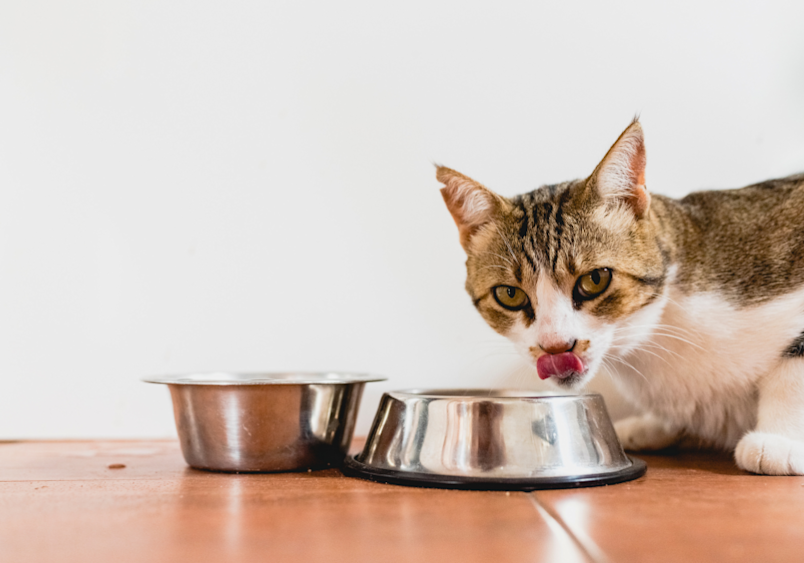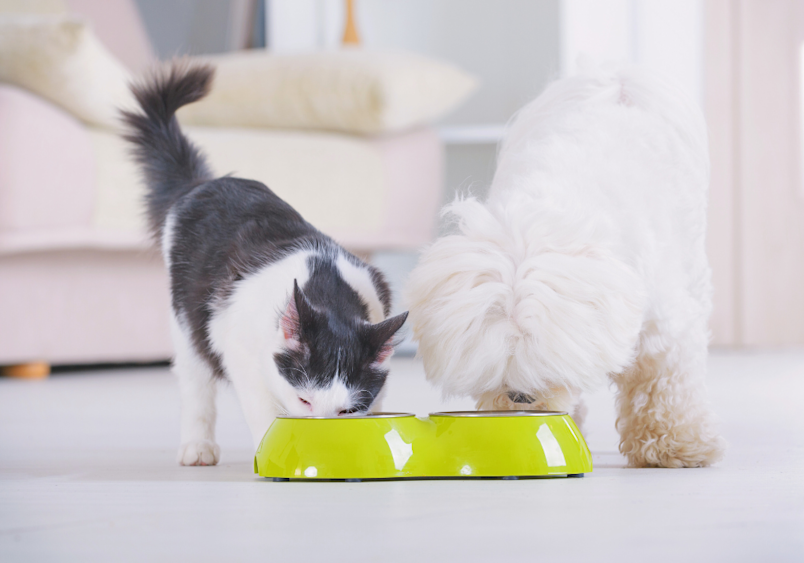
Caught your dog sneaking a few bites from the cat’s bowl? Wondering if it’s okay for your pets to share meals in a pinch? You’re not alone. Many pet parents assume that food made for one furry friend should work fine for another, after all, both dogs and cats are meat-eating, tail-wagging members of the family, right?
Not quite.
Cat food and dog food may look similar, but they’re built on very different nutritional foundations. Feeding the wrong food—even occasionally—can lead to digestive upset, nutrient imbalances, or even long-term health issues.
To help you understand dog food vs cat food, we’ll break down the real differences between dog and cat diets, why species-specific nutrition matters, and what to do when your pup raids the cat dish (or vice versa). Whether you're dealing with a curious eater or a food emergency, here's what you need to know to keep both pets healthy, happy, and thriving.
What's the Difference Between Cat Food and Dog Food?
Understanding the nutritional differences between cat and dog food isn't just pet parent trivia, it's important knowledge that impacts your pet's health and well-being. Let's break down why cats and dogs need different diets.
Why Can't Cats and Dogs Share Food?
Dogs and cats perceive food differently. For example, among other differences, cats don't have the ability to taste anything sweet. Their reduced range of what they consider palatable helps explain why dog food doesn't tend to attract cats as much as cat food does dogs.
Here's What Sets Their Nutritional Needs Apart:
Protein Requirements: Cats, as obligate carnivores, need significantly higher protein levels than our omnivorous dogs. While some premium dog foods offer high protein content, most don't provide the levels our feline friends require to thrive.
Vitamin A Production: Dogs have the ability to turn beta carotene into Vitamin A, a feat cats' bodies can't manage. That's why Vitamin A must be supplied in cat food. While plenty of dog foods may contain additional vitamin A, they aren't necessarily formulated to offer the amounts a cat requires for a lifetime of optimum health.
Taurine Necessity: Taurine is considered an essential amino acid for cats. Therefore, all cats require it. Dogs, on the other hand, can make their own taurine, which is why many dog foods are deficient in this nutrient. A cat fed dog food lacking sufficient taurine risks developing blindness and a potentially fatal heart condition called hypertrophic cardiomyopathy.
Arachidonic Acid: This fatty acid is something dogs can produce themselves. Cats, however, must get it from their diet. Without adequate arachidonic acid, cats can develop skin problems, reproductive issues, and kidney damage.
Can Dogs Eat Cat Food?
The short answer is: occasionally, yes, but regularly, no. While a single serving of cat food won't harm most healthy dogs, regular consumption isn't recommended.
Is Cat Food Bad for Dogs?
The high protein and fat content in cat food that's perfect for felines can wreak havoc on a dog's digestive system and waistline. When dogs eat cat food regularly, they're at risk for:
Obesity: Cat food's caloric density can quickly lead to unhealthy weight gain in dogs.
Gastrointestinal Upset: Many dogs develop diarrhea, vomiting, or gas after eating rich cat food.
Pancreatitis: This painful, potentially life-threatening inflammation of the pancreas can be triggered in sensitive dogs by the high-fat content in cat food – sometimes after just one meal.
Nutrient Imbalance: Over time, the different vitamin and mineral profile in cat food can create imbalances in a dog's system.
Can Dogs Eat Wet Cat Food?
Wet cat food poses even more risk to dogs than dry cat food due to its higher fat content and richer flavor profile. The aromatic, meaty goodness of wet cat food is particularly irresistible to dogs, making it a common culprit in dietary indiscretion cases.
If your dog has a sensitive stomach, even a small amount of wet cat food could trigger digestive issues. The palatability makes it especially problematic since dogs are more likely to overindulge if they gain access.
Is Dry Cat Food Bad for Dogs?
While slightly less problematic than wet formulations, dry cat food still isn't appropriate for your dogs as a regular meal. Even premium kibble designed for cats contains the wrong balance of nutrients for canine health.
Occasional nibbles from the cat's bowl won't cause immediate harm to most healthy dogs, but it shouldn't become a habit. If you catch your dog sampling the cat's kibble, don't panic—but do take steps to prevent future snacking adventures.

Can Cats Have Dog Food?
Feeding dog food to cats is actually more concerning than the reverse scenario. Cats have specific nutritional requirements that simply aren't met by dog food. Because unlike dogs, cats can’t adapt to nutrient gaps.
Is Dog Food Good for Cats?
In short, absolutely not. Dog food lacks several essential nutrients that cats cannot live without. Remember those critical nutritional differences we explored earlier? They become deal-breakers when considering whether cats can safely eat dog food.
Even the highest quality, premium dog food cannot meet a cat's fundamental needs for:
Sufficient taurine – Without enough of this amino acid, cats can develop potentially fatal heart disease (dilated cardiomyopathy) and progressive blindness.
Adequate vitamin A – Cats lacking proper vitamin A levels risk compromised immunity, deteriorating vision, and poor skin and coat health.
Essential arachidonic acid – A deficiency in this fatty acid can trigger skin inflammation, abnormal liver function, and reproductive failures in cats.
Appropriate protein levels – Insufficient protein leads to muscle wasting, weakened immune function, and overall poor health in felines.
Is Dog Food Bad for Cats?
Yes, as a regular diet, dog food can be harmful to cats. A cat who eats dog food exclusively will develop deficiencies that can lead to serious health problems.
A taurine deficiency, as mentioned, doesn't show symptoms immediately. By the time signs appear (often as heart problems or vision issues) the damage may be irreversible. This makes feeding dog food to cats particularly dangerous, as the harm occurs gradually and might not be noticed until it's severe.
If you find yourself in a true emergency with an empty cat food container, a single serving of dog food won't immediately harm most healthy adult cats. However, a better alternative would be offering a small portion of plain cooked chicken or turkey (about 1/4 to 1/3 cup for an average-sized cat, similar to how much you should feed your cat at a regular meal), which better meets your feline's nutritional needs than borrowing from your dog's dinner bowl.
The Role of Meat in Cat and Dog Diets
The type and amount of meat in pet food reflect the different nutritional needs of cats and dogs. Knowing these species-specific differences explains why their diets are not interchangeable.
Cats are obligate carnivores, meaning they rely on meat to meet essential nutritional needs. They require higher levels of animal protein and fat to fuel their energy and cannot produce certain nutrients on their own. That’s why cat food is rich in animal-based ingredients and low in carbohydrates.
Dogs, on the other hand, are more flexible. While they benefit from meat proteins, their omnivorous digestive systems allow them to process plant-based nutrients effectively. They can synthesize some nutrients cats cannot, such as taurine, and convert beta-carotene into vitamin A.
When choosing pet food, always prioritize species-appropriate nutrition:
For cats: Look for high-quality, animal-based proteins as the main ingredients.
For dogs: Aim for a balanced mix of proteins, healthy fats, and digestible carbohydrates.

Why Should Dogs and Cats Stick to Their Own Food?
While feeding your cat dog food temporarily when you're in a pinch is unlikely to cause immediate harm (provided your cat will eat it and is otherwise healthy), it's not a sustainable practice. Similarly for dogs, though they might eagerly devour cat food, regular consumption can lead to digestive upset, weight gain, and potential long-term health issues like pancreatitis in sensitive animals.
The simple truth is that pet food manufacturers invest significant research into developing species-specific nutrition. Each formula is carefully designed to provide optimal health for either cats or dogs – not both. These formulations account for the distinct digestive systems, metabolic processes, and nutritional requirements of each species.
Pet foods today are scientifically formulated to meet very specific nutritional needs. Ignoring the distinct dietary requirements of cats and dogs can put their long-term health at risk.
What to Do If Your Dog Has Eaten Cat Food?
If your dog has helped himself to the cat's dinner, don't panic and assess the situation calmly. For most healthy dogs, a small amount of cat food won't cause immediate problems. However, be vigilant if your dog:
Has consumed a large quantity
Has a history of pancreatitis or digestive sensitivity
Is a puppy, senior, or has existing health conditions
Shows signs of distress like vomiting, diarrhea, or lethargy
Prevention is the best strategy. Consider investing in microchip-activated feeders that only allow your dog and cat access to their food, or place cat food in elevated areas your dogs can't reach. If concerning symptoms develop after a food exchange incident, contact your veterinarian promptly.
Protect Your Pet's Dietary Health and Have Peace of Mind with Pet Insurance
Even with careful management, pets sometimes get into foods they shouldn't. When a midnight cat food raid leads to pancreatitis or other digestive emergencies, treatment costs can quickly escalate into thousands of dollars. This is where pet insurance proves invaluable, providing financial protection when unexpected dietary mishaps occur.
Embrace pet health insurance can cover a sufficient amount of eligible veterinary expenses after your deductible, transforming a potential $3,000 emergency bill into a much more manageable expense. Beyond dietary indiscretions, these policies typically cover accidents, illnesses, diagnostic tests, surgeries, and medications your pet might need throughout their life. Many providers also offer optional, non-insurance wellness plans that help manage the cost of preventative care, including nutritional counseling that could help avoid dietary issues altogether.
The cost of emergency treatment for pancreatitis in dogs ranges from $500 to $4,000, with complex cases potentially costing more. Pet insurance doesn't prevent dietary mishaps, but it does ensure that if your dog or cat requires emergency care after eating inappropriate food, you can focus on their recovery rather than worrying about the financial burden of treatment.
The Right Food for the Right Pet
The moral of the story? Dog food is for dogs and cat food is for cats. Your cat and dog may share your couch, your affection, and maybe even a few toys—but when it comes to food, they need their own bowls and their own diets.
So the next time you catch your pup eyeing the cat’s dinner, or you’re tempted to feed your feline a scoop from the wrong bag, remember: what’s convenient in the moment isn’t always what’s best in the long run.
In fact, many human foods that are safe for dogs—like certain lean meats and vegetables—can be smarter temporary options than reaching for the wrong pet bowl. And if mishaps happen (because let’s face it, they do), having a good pet insurance plan in place can make all the difference.
Your pets count on you for more than cuddles and belly rubs—they count on you to feed them right. Keep their diets species-specific, and you’ll be giving them the gift of better health, fewer vet visits, and more happy years by your side.